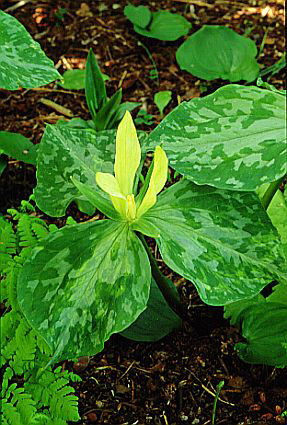Trillium luteum
yellow wood trillium
A perennial to 45cm, with whorled, broadly ovate leaves mottled with silvery green, and solitary terminal yellowish green flowers with narrow, upright petals to 9cm in length
Size
Ultimate height
0.1–0.5 metresTime to ultimate height
2–5 yearsUltimate spread
0.1–0.5 metresGrowing conditions
Moisture
Moist but well–drainedpH
Acid, NeutralColour & scent
| Stem | Flower | Foliage | Fruit | |
| Spring | Green Yellow | Green | ||
|---|---|---|---|---|
| Summer | Green | |||
| Autumn | ||||
| Winter |
Position
- Full shade
- Partial shade
Aspect
North–facing or West–facing or East–facing
Exposure
Sheltered Hardiness
H5Botanical details
- Family
- Melanthiaceae
- Native to GB / Ireland
- No
- Foliage
- Deciduous
- Habit
- Columnar upright
- Genus
Trillium are rhizomatous, herbaceous perennials with erect stems bearing a whorl of ovate or diamond-shaped leaves, with one or more erect or nodding flowers borne at the stem apex
- Name status
Correct
- Plant range
- E North America
How to grow
Cultivation
Grow in deep, moist but well-drained, humus-rich, preferably acid to neutral soil in deep or partial shade. Mulch in autumn with leaf mould. See trillium cultivation
Propagation
Propagate by seed in pots in a shady cold frame as soon as seed is ripe; takes 5-7 years to reach flowering size. Propagate rhizomes by division after flowering or cut out the growing point from the rhizome after flowering, which stimulates the formation
Suggested planting locations and garden types
- Flower borders and beds
- Underplanting of roses and shrubs
Pruning
No pruning required
Pests
Diseases
Generally disease-free
Love gardening
Sign up to receive regular gardening tips, inspiration, offers and more
View our Privacy Policy
Get involved
The Royal Horticultural Society is the UK’s leading gardening charity. We aim to enrich everyone’s life through plants, and make the UK a greener and more beautiful place.
